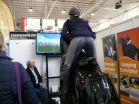(Press-News.org) Increasing the number of female speakers at a scientific conference can be done relatively quickly by calling attention to gender disparities common to such meetings and getting more women involved in the conference planning process, suggests a Johns Hopkins Bloomberg School of Public Health researcher.
Reporting online Aug. 4 in the journal mBio, Arturo Casadevall, MD, PhD, professor and chair of the W. Harry Feinstone Department of Molecular Microbiology and Immunology at the Bloomberg School, lays out how the American Society of Microbiology General Meeting was able to increase the percentage of female speakers from 27 percent in 2011 to nearly 50 percent in 2015. This comes at a time when women make up a significant majority of scientific trainees and oral presentations at important conferences are seen as one key to academic advancement.
"Invitations to speak at major meetings are prized by scientists because they provide visibility and the ability to present their work to an audience of their peers," says Casadevall, who is also the editor of mBio. "When you have an underrepresentation of women as speakers and many panel discussions made up only of male researchers, you're sending the message that perhaps the field is not welcoming to women. That isn't the message we want to send."
Casadevall says that in 2013, the committee charged with planning the 2014 American Society of Microbiology general meeting was presented with data from 2011 to 2013 outlining the low numbers of women who spoke at those conferences. They were also shown data suggesting that when at least one woman was in the group that invited panelists to appear, there were 72 percent more female speakers in those sessions and there was a 70 percent reduction in the likelihood of an all-male panel. After being presented with the data during the planning phase of the conference, there was a 43 percent uptick in female speakers at the 2014 meeting, up from an average of 30 percent for the previous three years. However, there was no significant impact on the number of all-male sessions.
Before 2015's meeting, the planning committee was reminded of the underlying issue and urged to do even better. At the 2015 conference, gender equity was achieved, with 48.5 percent of the speakers being female and the percentage of sessions with all-male speaker rosters dropping dramatically to 4 percent. This meant that roughly 100 more women presented in 2014 and 2015 than would have been expected based on the averages of the prior three conferences. Casadevall was the chair of the American Society of Microbiology General Meeting's 2014 and 2015 program committee.
Casadevall says that the number of all-male panels fell from 20 percent to 4 percent between 2011 and 2015. In 2015, no planning group that included at least one woman picked an all-male panel.
He says the issue of gender inequity among conference speakers is not unique to his field, but has been a well-understood issue across a number of academic areas, despite increases in the percentage of women scientists.
He says he believes that including women in the groups charged with choosing speakers increases the chances of getting female speakers because women are more likely to have women in their networks and they are more likely to notice during the planning process that women are underrepresented.
"We all have our biases - intentional or unintentional - and we need to find a way to overcome them," he says. "Maybe this won't be a problem in science in the future, but now it is and here we found a way to ensure that our conference doesn't leave anyone out on the basis of gender."
INFORMATION:
"Achieving Speaker Gender Equity at the American Society of Microbiology General Meeting" was written by Arturo Casadevall.
COLUMBUS, Ohio - New mothers take a close look at their personal relationship with their husband or partner when deciding how much they want him involved in parenting, new research finds.
The study found that mothers limited the father's involvement in child-rearing when they perceived their couple relationship to be less stable. Mothers also limited fathers who were less confident in their own ability to raise children.
The bottom line is that new mothers are assessing their partners' suitability to be a parent, said Sarah Schoppe-Sullivan, co-author of the study and ...
When it comes to courting, one common spider species is quick to learn, and that learning process involves eavesdropping on the visual cues of rivals to win their mate. The latest discovery in a research partnership represented by Alma College, The Ohio State University at Newark and the University of Cincinnati is the featured article in the August issue of the international research journal Animal Behaviour.
Previous studies by the researchers explored how brush-legged wolf spiders (Schizocosa ocreata) used visual eavesdropping to try to outdo a male rival's leg-tapping ...
Cholera is a diarrhoeal disease that is caused by an intestinal bacterium, Vibrio cholerae. Recently an outbreak of cholera in Haiti brought public attention to this deadly disease. In this work, the goal of our differential equation model is to find an effective optimal vaccination strategy to minimize the disease related mortality and to reduce the associated costs. The effect of seasonality in pathogen transmission on vaccination strategies was investigated under several types of disease scenarios, including an endemic case and a new outbreak case. This model is an extension ...
WASHINGTON -- Chronic marijuana use by teenage boys does not appear to be linked to later physical or mental health issues such as depression, psychotic symptoms or asthma, according to a study published by the American Psychological Association.
Researchers from the University of Pittsburgh Medical Center and Rutgers University tracked 408 males from adolescence into their mid-30s for the study, which was published in Psychology of Addictive Behaviors.
"What we found was a little surprising," said lead researcher Jordan Bechtold, PhD, a psychology research fellow ...
HIV can continue to grow in patients who are thought to be responding well to treatment, according to research by the University of Liverpool.
During treatment for HIV the virus hides in blood cells that are responsible for the patient's immune response. The virus does this by inserting its own genetic information into the DNA of the blood cells, called CD4 Tlymphocytes.
The study by the University's Institute of Infection and Global Health measured the levels of integrated HIV in the CD4 cells of patients undergoing uninterrupted treatment for up to 14 years, and ...
A super-dense star formed in the aftermath of a supernova explosion is shooting out powerful jets of material into space, research suggests.
In a study published today, a team of scientists in the Australia and the Netherlands has discovered powerful jets blasting out of a double star system known as PSR J1023+0038.
It was previously thought that the only objects in the Universe capable of forming such powerful jets were black holes.
PSR J1023+0038 contains an extremely dense type of star astronomers call a neutron star, in a close orbit with another, more normal ...
Flight simulators for the training of air pilots are well known. But what about riding simulators? Although the first horse simulator was used at the French National Equestrian School in Saumur already in the 1980s, riding simulators for dressage, show jumping, polo or racing, have become available only recently. They look like horses and respond to the aids of the rider via sensors which measure the force exerted by the reins and the rider's legs. Via a screen in front of the simulator, the rider immerses himself into a virtual equestrian world.
Simulators are aimed ...
Scientists first had to re-think death before they could develop a way of testing the potential harm to the environment caused by thousands of chemicals humankind uses each day.
Researchers led by Dr Roman Ashauer, of the Environment Department at the University of York, refined the technique of survival analysis used routinely by toxicologists, biologists, medical researchers and engineers. The research could pave the way for testing the estimated 15,000 substances discovered daily.
Survival analysis which helps to predict a huge range of functions such as the survival ...
New research by scientists at New Zealand's University of Otago and GNS Science is helping to solve the puzzle of how bacteria are able to live in nutrient-starved environments. It is well-established that the majority of bacteria in soil ecosystems live in dormant states due to nutrient deprivation, but the metabolic strategies that enable their survival have not yet been shown.
The researchers took an extreme approach to resolving this enigma.
They studied a strain of acidobacteria named Pyrinomonas methylaliphatogenes that was cultivated from heated and acidic geothermal ...
A study including researchers from the U.S. Department of Energy's Argonne National Laboratory and the University of Chicago found evidence that gut microbes affect circadian rhythms and metabolism in mice.
We know from studies on jet lag and night shifts that metabolism--how bodies use energy from food--is linked to the body's circadian rhythms. These rhythms, regular daily fluctuations in mental and bodily functions, are communicated and carried out via signals sent from the brain and liver. Light and dark signals guide circadian rhythms, but it appears that microbes ...


